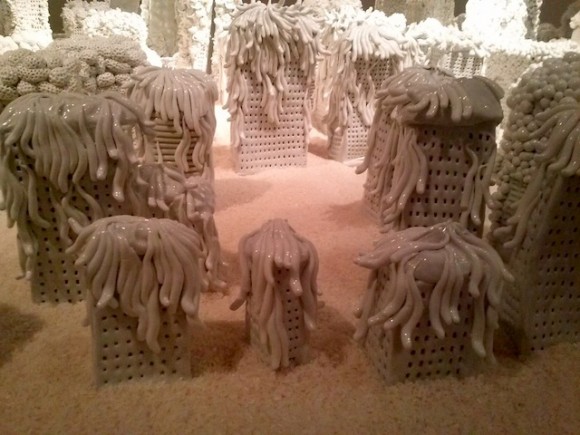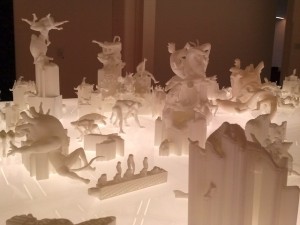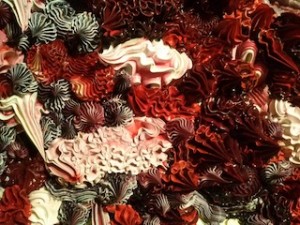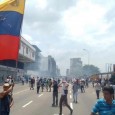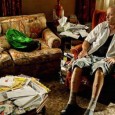I see it first from a distance. It is framed by the doorway and engulfed in bright light. I can’t tell what it is yet, but I do know it has drawn my attention. As I approach, I notice a young attendant staring at me from inside the room, inviting me in with her smile.
As I enter, my breathing becomes shallow, trying not to disturb the friendly silence in the air. Now that I’m standing over it, I realise I can’t really see what I’m looking a but squatting down, I can. I’m looking at a recreation of a city, one whose many buildings are made of shiny, white porcelain and stand so delicately on a bed of rice.
But my admiration all too quickly turns to horror, and then disgust. For on the top of the buildings, sprouting violently and making their way down the sides, are masses of worm-like tentacles. Others have mountains of fungi bubbles. Beijing, the porcelain city built on rice, is infested.
The 16-square-metre model of central Beijing, CBD, was produced by Chinese artist Zhou Jie, who is one of the many featured artists in the Smash Palace exhibition, now showing at the White Rabbit Gallery. The exhibition showcases the reactions of Chinese artists to the ‘new’ China: the product of Chairman Mao’s efforts after the Cultural Revolution.
My next stop, Wonderful City, is a 9.6-metre long 3D print on a light-box. It is another version of the city-landscape in China from artist Cheng Dapeng, in which grotesque, mutant creatures are physically a part of the architecture; the city is their ‘breeding ground’.
Upstairs, Jin Shi’s Mini-home, a tiny room that fits no more than you and I, illustrates the status and living conditions of poor urban migrants. The artist tries to express that “even their heights are shrinking”.
Staring down at this replica from the adjacent wall are Wang Guofeng’s ten photographs, Ideality, of the ten grand buildings erected during the Communist Revolution. A closer look reveals a tiny figure of a man in front of the building in each photo: the exhibit label tells me it is the artist himself and that it is “an assertion of individual freedom, the artist’s most basic need”.
I find myself more and more intrigued as I move through the gallery, so when I sit down to chat with Judith Nielson, the gallery owner, my mind is buzzing with questions and thoughts. She tells me that as an artist she appreciates being a collector.
“The majority of people just think art is something you stick on a wall to fill up space and you don’t have to think about it,” she says, “whereas everything here you actually should wonder about.”
I ask her what she thinks the artists are doing, through their art.
“They’re looking at what’s happened in their past; they’re looking at how the West is influencing them and they’re looking at how perhaps – at this stage – the two things aren’t really working together.”
Nielson’s daughter Paris curated the exhibition, and the gallery owner glows with pride as she tells me what she thinks of her daughter’s approach. “She was putting together a story about the progress of China regarding the building… and displacement of people.”
The artworks in the exhibition are telling a story about China’s past, present and future. At the beginning of the Cultural Revolution, Chairman Mao set out to ‘smash’ the Four Olds: old ideas, customs, culture and habits of mind.
Since then, modernisation has seen the rapid urbanisation of China’s cities. Rural dwellers migrate to the city to find work, and the families they left behind rely on their meagre income. Traditional historic residential areas are demolished to make way for skyscrapers in the construction of mega-cities. These changes have had underlying yet growing implications, the White Rabbit website explains: “People’s anxiety is rising as fast as their expectations [because] as new possibilities emerge, old certainties are falling apart.”
Dr Beatriz Carrillo-Garcia, a lecturer in China Studies at the University of Sydney, says that the city has created pressures for Chinese people, like financial hardship and materialistic greed.
“I think that people are dissatisfied with life in the cities,” she says. “They see it as ‘now we have poverty, now we have more crime, [and] people are being marginalised’.”
For the young in the city especially, there are great expectations.
“They’re the only child, they’ve got to deliver, and their parents put all their savings into their education or into buying them an apartment and so on. If then, at the end they don’t get a job, or get a job that doesn’t pay them out, they’re a failure.”
But despite all this the city remains the ‘ideal place’ to be.
“The city does represent that kind of harsh competition,” she says. “It doesn’t care for the individual but at the same time, the urban [environment] represents modernity.”
As a result of this contradictory love-hate nature of the city, generated by the rapid urbanisation of China’s cities, the pressure is mounting. And so the exhibition is suitably titled, suggesting that, “the monolithic edifice of Party rule is starting to show cracks”.
The mega-city in China is representative of this ‘monolithic edifice’ Dr Carillo-Garcia says.
“Before, during the socialist, communist period, people had very similar lives so there were not a lot of disparities between what an industrial worker did or a government worker did in different cities, whereas Chinese society has become so complex.”
And this, she says, is causing much anxiety.
To the artists of the Smash Palace exhibition, the mega-city is very fragile. It might be new and shiny, but as history painter and portraitist Jia Wei says, it is just asking to be smashed.
“It is ugly but beautiful, powerful. The artworks express worry about the future of human beings.”
Drawing from personal experience, Wei observes that artists are people of feeling and can never speak for the majority; they can only express their own opinions, and it is for this reason that the exhibition is so emotionally charged.
“I think, whether [urbanisation] is good or bad, we cannot stop it. But we’ll always have some nostalgia,” Wei says.
” There are negative implications of the rapid urbanisation of China for Chinese society. It’s like, at the side of older Beijing, you build a palace. You demolish the older town and you build everything new… it’s stupid. A city becomes a dream, and a dream becomes bigger.”
And so does the grey weather balloon that you can’t miss in the far corner of the top level of the gallery. Zhou Xiaohu’s Even in Fear makes me feel anxious as soon as a motor begins to drone loudly. I watch as the balloon begins to inflate, getting bigger, and bigger, and bigger, until it touches the ceiling. It continues to expand, and as soon as you think it’s about to burst, it starts to deflate. At that moment, everything the artworks were trying to convey was expressed right there, in that balloon. And as I turn my back on it to leave I realise my breathing has become shallow, again.
But this time, it wasn’t my choice.

